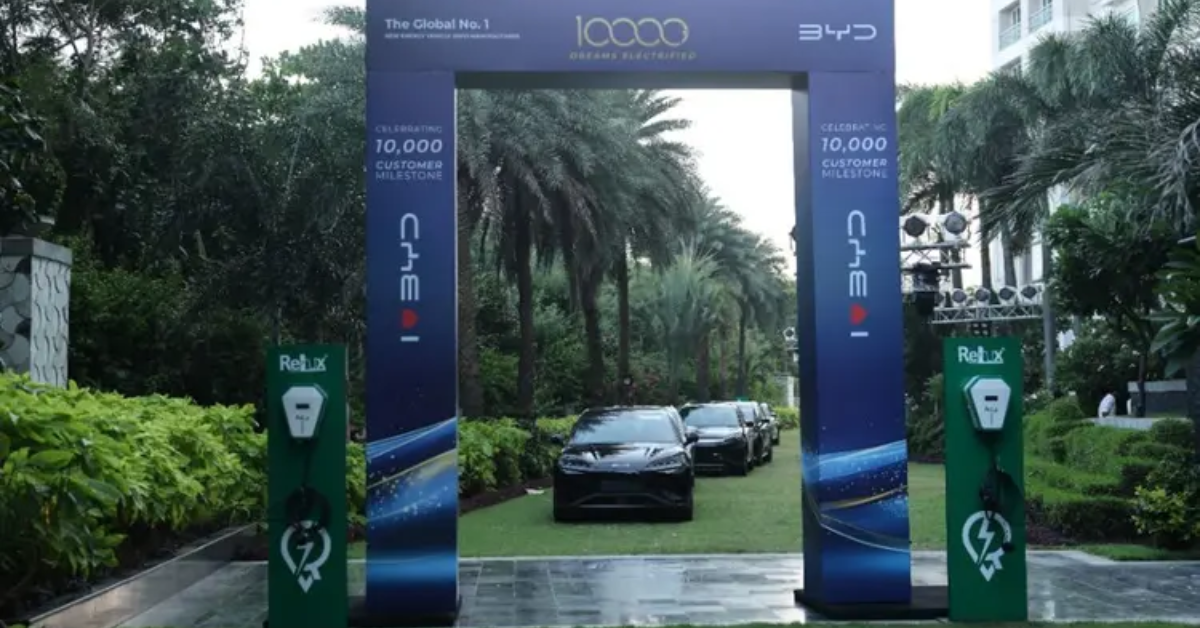BYD (Build Your Dreams), the Chinese electric vehicle giant, has been making steady inroads into the Indian market. The brand, which is already the world’s leading EV manufacturer by sales volume, recently announced that it has crossed the 10,000-unit sales milestone in India. This achievement is not just a number but a sign of how the Indian electric vehicle ecosystem is evolving.
As India pushes for greener mobility and reduced dependence on fossil fuels, BYD’s performance highlights both consumer interest in EVs and the growing trust in international EV brands. Let’s take a closer look at what this milestone means for BYD, the Indian market, and the future of electric mobility in the country.
BYD’s Journey in India
BYD entered India with its electric buses and then expanded its portfolio to passenger vehicles. Its passenger EV lineup currently includes:
- BYD e6 MPV – A practical, long-range electric MPV designed for both families and fleet usage.
- BYD Atto 3 SUV – A stylish electric SUV loaded with modern technology, which has gained popularity among urban buyers.
- BYD Seal (upcoming) – A high-performance electric sedan expected to strengthen BYD’s premium EV portfolio in India.
From limited initial presence to becoming a recognized EV brand, BYD has successfully positioned itself as a strong player competing with brands like Tata Motors, Hyundai, and MG in India’s EV landscape.
Why the 10,000 Sales Milestone Matters
Crossing 10,000 units may sound modest when compared to mass-market players, but for an international brand in India’s still-nascent EV sector, this is a significant achievement. Here’s why:
- Growing Consumer Trust – Indian buyers are showing confidence in premium EV brands like BYD, which were initially seen as niche.
- Expanding EV Awareness – The milestone reflects that EVs are moving from “early adopters” to mainstream buyers.
- Support for Government Goals – With India targeting 30% EV adoption by 2030, every milestone by global brands like BYD adds to momentum.
- Better Infrastructure Development – Rising EV adoption encourages faster rollout of charging infrastructure.
How BYD Achieved This Growth
1. Focus on Range and Battery Tech
BYD’s cars are known for long driving ranges and advanced Blade Battery Technology, which offers higher safety and durability. For Indian buyers concerned about charging infrastructure, range plays a critical role.
2. Premium Features and Safety
The Atto 3, for example, comes with advanced safety features, stylish interiors, and futuristic technology—helping it attract urban buyers who want luxury with sustainability.
3. Fleet Adoption
The BYD e6 has been adopted widely by fleet operators and cab services, especially in metro cities. This bulk demand has played a huge role in sales numbers.
4. Brand Strategy
BYD positioned itself not just as an EV company but as a global clean energy leader, which resonates with India’s climate-conscious buyer base.
Competition in the Indian EV Space
The EV market in India is heating up with multiple players competing for attention:
- Tata Motors dominates the space with affordable EVs like Nexon EV and Tiago EV.
- MG Motor India offers the MG ZS EV, a direct competitor to BYD Atto 3.
- Hyundai is expanding its EV lineup with the Kona and the upcoming Ioniq 5.
- Mahindra is preparing to launch its XUV.e series, which will further intensify competition.
BYD’s 10,000-unit sales show that even with competition, there is enough demand for multiple brands to thrive.
What’s Next for BYD India?
BYD is not stopping at 10,000 units. The company has big plans:
- Launch of BYD Seal – A sporty electric sedan that could rival Tesla in India.
- Expansion of Dealerships – More showrooms and service centers to improve customer reach.
- Localized Manufacturing – Reports suggest BYD is considering local production to bring down costs and qualify for government incentives.
- Partnerships for Charging Infrastructure – Collaborations with charging network providers to boost accessibility for customers.
Impact on India’s EV Future
BYD’s growth signifies that India is ready for premium EVs. The country is no longer just looking for budget-friendly electric hatchbacks but also embracing global EV technology and luxury options. This also puts pressure on other automakers to fast-track their EV strategies for India.
For consumers, the increasing competition means more choices, better technology, and eventually, more affordable prices. For the government, milestones like this align with clean mobility and energy transition goals.
Conclusion
The fact that BYD India has sold over 10,000 electric vehicles is a strong indicator of how the EV wave is gathering momentum in India. From fleet adoption to premium SUVs, BYD has managed to carve out a niche in a competitive market.
Looking ahead, the launch of new models, possible local manufacturing, and growing consumer trust will likely propel BYD even further. For India, this milestone is yet another step toward a cleaner, greener, and more sustainable automotive future.
